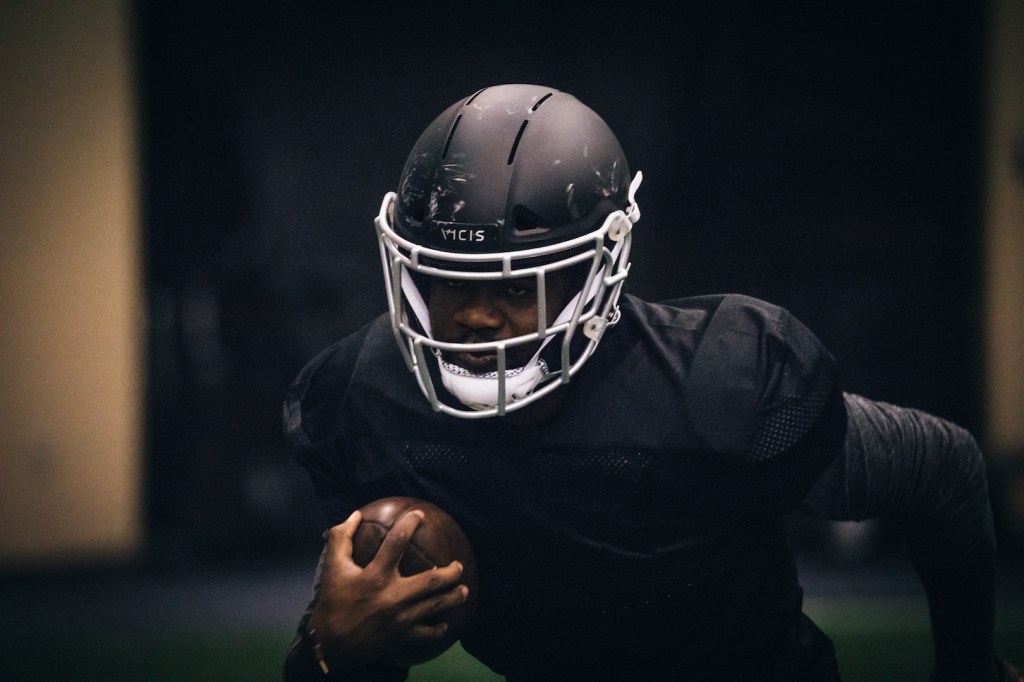Over a million people play football every year, but helmet technology hasn’t changed much since the 1970s.
With mounting evidence that athletes’ repetitive head trauma results in devastating long-term damage, the football world has been eager for solutions. So the ZERO1, a new helmet designed with the latest technology to protect players from concussions or other head injuries, is understandably popular.
Videos by VICE
But while the helmet may be the safest option on the market, there’s a potential hidden peril: the security of a safe helmet may drive football players toward more unsafe behavior.
Created by a Seattle start-up called VICIS, the ZERO1 has been heralded as a much-needed improvement in helmet technology. So far, 30 of 32 NFL teams and 30 NCAA (college) teams have tried out the helmet, which features several layers of padding and a soft shell. Earlier this month, 12 teams ordered additional helmets and VICIS announced an additional $10 million in funding, bringing its total funding up to $40 million.
But that doesn’t mean it’s working.
“If [players are] mentally or psychologically convinced that the helmet they’re wearing is the best helmet out there, they may be even less careful because they think they’re more protected,” explains Erik E. Swartz, professor and chair of kinesiology at the University of New Hampshire, who has also served as a consultant for the NFL’s Head, Neck, and Spine safety subcommittee.
Swartz studies how equipment affects player safety, and he’s found that players’ perceptions of safety plays a huge role in how they behave. When you have a helmet on, he says, “you can bang your head against something and it doesn’t hurt, but the problem is that the brain is still sloshing around.” The accumulation of successive mild impacts can still cause long-term damage, even if players show no signs of injury.

Swartz has been advocating for interventions with players to recalibrate their assessment of risk by forcing them to practice without helmets. “The idea is that if you take helmets off football players and have them practice the technique of tackling and blocking, they’ll adopt learned motor behaviors,” he says.
In a 2015 study by Swartz and his colleagues, published in the Journal of Athletic Training, college football players who practiced without helmets and got training in helmetless tackling techniques endured 30 percent fewer head impacts over the course of the season than players who practiced with helmets. Swartz and his team have since developed a Helmet-less Tackling Training program (HuTT), which has been adopted by the UNH football team and several local high school teams.
So far, it’s unknown exactly how much a high-tech safe helmet like the ZERO1 affects a player’s behavior. “The extent to which [the helmet] perpetuates a false sense of safety is hard to measure,” says Swartz. “But you don’t want to stop the innovation.”
And the ZERO1 does offer improved protection against the inevitable impacts over the course of a game: the helmet includes a “reflex layer” that reduces rotational forces, something previous helmets don’t protect against, and VICIS has made strides in improving visibility, customizing helmet size, and introducing emergency features like a quick release jaw pad, so that if players are injured and must be kept stable, the helmet can still be easily removed.
VICIS co-founder and neurosurgeon Sam Browd believes that safer football can only come from a combination of safer behavior and better equipment. “There’s never going to be a piece of safety equipment that’s going to completely eliminate concussions,” he says. “These technology advancements should ideally be accompanied by improved coaching and rule changes that reinforce proper technique.”
Playing without helmets might teach players safer techniques, but that can’t eliminate the threat of head injury, either; athletes playing helmet-less contact sports like rugby still see their fair share of head injuries, though those rates appear to be lower than among football players.
Plus, Browd says, he doesn’t see the helmet going away anytime soon: it’s tradition. “It’s not American football if you’re not wearing a helmet.”
Get six of our favorite Motherboard stories every day by signing up for our newsletter .
More
From VICE
-

Photo: janiecbros / Getty Images -

Photo: NATALIA ANDREEVA / Getty Images -

(Photo by John Nacion/Variety via Getty Images) -

Illustration by Reesa
